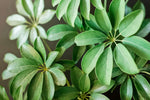
Schefflera
$32.00 USD
Unit price perEstimated delivery between December 31 and January 02.
Schefflera, commonly called umbrella plants or trees, make excellent tropical houseplants. The larger Schefflera actinophylla features long, shiny, oval green leaves that droop gracefully from a central stalk, resembling an umbrella. Schefflera arboricola (dwarf schefflera) features smaller, glossy leaves, sometimes with creamy variegation.
These easy-growing plants can live 25 years or longer and produce flowers, but plants grown indoors rarely develop flowers. Schefflera grows best in indirect light, requiring a rich, loamy, well-draining soil and temperatures consistently warmer than 60°F. All parts of the schefflera plant are mildly toxic to humans and seriously toxic to dogs and cats.
Schefflera Care
Here are the main care requirements for growing schefflera plants:
- Schefflera requires indirect, bright light. Growing in lower light conditions could result in less growth or the plant becoming leggy.
- Requires warm temperatures above 60°F at all times.
- Thrives in a rich, well-draining, acidic potting soil.
- Feed twice weekly during the growing season.
- Give water only when the soil dries out to prevent overwatering.
- Tolerates average indoor humidity at 30% but prefers higher humidity, preferably 40%.
Planting
Plant schefflera in the spring or fall when the weather is more mild and not too hot. If growing outdoors, you'll want to select a location that gets bright yet indirect light.
If growing indoors, place your plant by a bright window that gets indirect light as full sun can burn the plant's leaves. Plant with a well-draining potting soil and water when the top inch of soil becomes dry.
Light
Schefflera prefers bright, indirect light. In the summer, move potted plants outside where they will receive bright light but not direct sun, such as under a patio cover.
A schefflera plant that gets leggy or floppy might not receive enough light. Never place a schefflera in direct, full sunlight because the intense sun can burn the leaves.3
Soil
If growing indoors, plant schefflera in a rich, loose, well-drained potting soil. A well-draining, sandy loam soil with a slightly acidic pH is ideal when grown outdoors. Avoid planting outdoors where the soil becomes too wet or soggy.
Water
Water regularly during the growing season and spray the leaves with water frequently. Wait until the pot's soil dries out, then give it a deep and thorough soaking. Cut back on water during the winter months. Yellow and dropped leaves indicate that you might be watering too much.
Temperature and Humidity
Because it is a tropical plant, schefflera requires relatively high humidity and tropical temperatures; it will suffer in temperatures lower than 60°F. Do not expose these plants to drafts or dry heating vents. In cold climates, bottom heat might be necessary.
An underwatered or cold schefflera will begin to drop leaves quickly. If the plant loses all its leaves, you can attempt to save it by moving it outdoors in the spring and watering generously.
Fertilizer
Feed schefflera plants twice a week during the growing season with liquid fertilizer for houseplants, or use two applications of slow-release pellets. They are heavy feeders and will benefit from the extra nutrients.
All sales of live plants are final; returns are not accepted.
Share
FEADTURED COLLECTIONS
Enhance your home with our collection of indoor plants, designed to purify the air and add a touch of natural beauty to any room. Easy to care for and perfect for any space.
Discover the elegance and beauty of our 'Orchids & Flowers' collection, featuring a curated selection of vibrant blooms that add a touch of nature's finest artistry to any space. From the exotic allure of orchids to the timeless charm of classic flowers, each plant is carefully chosen for its unique beauty and ability to bring life and color into your home. Perfect for plant lovers and decorators alike, this collection offers a range of options to suit every style and occasion.
Myrtle Topiary
From $28.00 USD
Unit price perBegonia Red Fred
From $45.00 USD
Unit price perMarantha Prayer Plant
From $18.00 USD
Unit price per



































